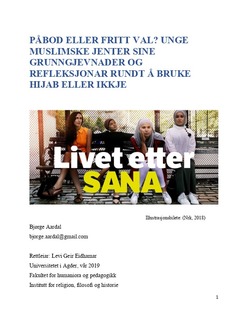| dc.description.abstract | This master thesis involves what justifications and reflections young Muslim girls have for using the hijab or not. Through depth-interviews of 15 youths, aged between 13 and 19 at different schools in two regions in Norway who did and did not wear the hijab, this thesis closely examines their thoughts regarding the Islamic headscarf. Through my work with responses from the informants, a pattern centering round whether they viewed wearing the hijab as a religious injunction or as a free choice rapidly emerged. Exactly this was the foundation for why parts of the title contain the question «Injunction or free choice?”. As a basis for an analysis of the informants’ justifications and reflections around wearing the hijab or not, I used two models deductively. First Levi Geir Eidhamar’s «Rett -godt » typology and second Fatima Mernissis’ three dimensions about the hijab. In addition, I looked for other special characteristics in the interviews of the youth, as an inductive approach to the material. Through this inductive approach, a patternemerged in the source material between the hijab as a religious injunction and as a free choice. Furthermore, this patternbetween religious injunction and free choice was the basis for a typology specially developed for this thesis. Especially through the “Rett -godt” typology many religious justifications among the informants materialized. Some youths claimed that the hijab would both secure a life after death and a good life on earth. On the other hand, some claimed that that the scarf had no bearing on the afterlife, positive or negative. Both youth who did and did not wear the hijab showed much diversity in both justifications and reflections about the headscarf. Fatima Mernissis’ three dimensions about the hijab directed the analysis of the interviews to the life here and now, with and without the headscarf. For the girls, wearing the hijab signaled that they were devout Muslims and they felt thatthe veil compelled them to act ethically.Furthermore, the thesis deals with some connectionsin hijab usage among the young regarding family, the homeland versus Norwayand religiousness. Through working with the source material, I also developed the «Injunction –free choice» topology, which in essence dealt with whether or not the youths viewed the hijab as a religious injunction and with their own use, or non-use, of the headscarf. | nb_NO |

